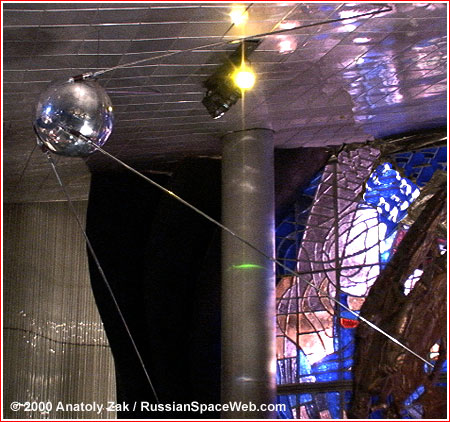
This replica of the PS-1 (Sputnik-1) hangs in the Cosmonautics Memorial Museum in Moscow.
Fifty years ago on October 4, the Soviet Union launched its prosteishy sputnik, or simplest satellite. It stayed in Earth’s orbit for 22 days, sending back a signal to announce that the space age had begun. Sputnik only weighed about 80 kg, but it hit this country like a flying sledge hammer, writes NASA scientist Homer Hickham, who grew up dreaming about space travel in a small West Virginia town. Hickham’s eloquent speech on the history and future of the space program was a highlight of a May 2001 NASA symposium, the proceedings of which are titled “Looking Backward, Looking Forward”  .
.
The most comprehensive resource on Sputnik is RussianSpaceWeb  , an independent site maintained by journalist Anatoly Zak. SpaceWeb’s Sputnik materials include technical descriptions, first-person accounts from Russian scientists, accounts of the political impact in the USSR, and much more.
, an independent site maintained by journalist Anatoly Zak. SpaceWeb’s Sputnik materials include technical descriptions, first-person accounts from Russian scientists, accounts of the political impact in the USSR, and much more.
Many more Sputnik links can be found on the web page of the NPR talk show Science Friday  , which devoted an hour to Sputnik’s 50th anniversary on September 28. Go here for a selection of American reactions to Sputnik, including a contemporary newsreel and discussions of the launch’s impact on science education. A highlight is a NASA recording of the sound the satellite made as it orbited the earth. Its distant high-pitched “beep” sounds eager and friendly, more like a high school science project than a threat to national security.
, which devoted an hour to Sputnik’s 50th anniversary on September 28. Go here for a selection of American reactions to Sputnik, including a contemporary newsreel and discussions of the launch’s impact on science education. A highlight is a NASA recording of the sound the satellite made as it orbited the earth. Its distant high-pitched “beep” sounds eager and friendly, more like a high school science project than a threat to national security.


Sputnik was a great achievement for the mankind and for the Soviet Union.
rk
http://www.sungatephotography.com